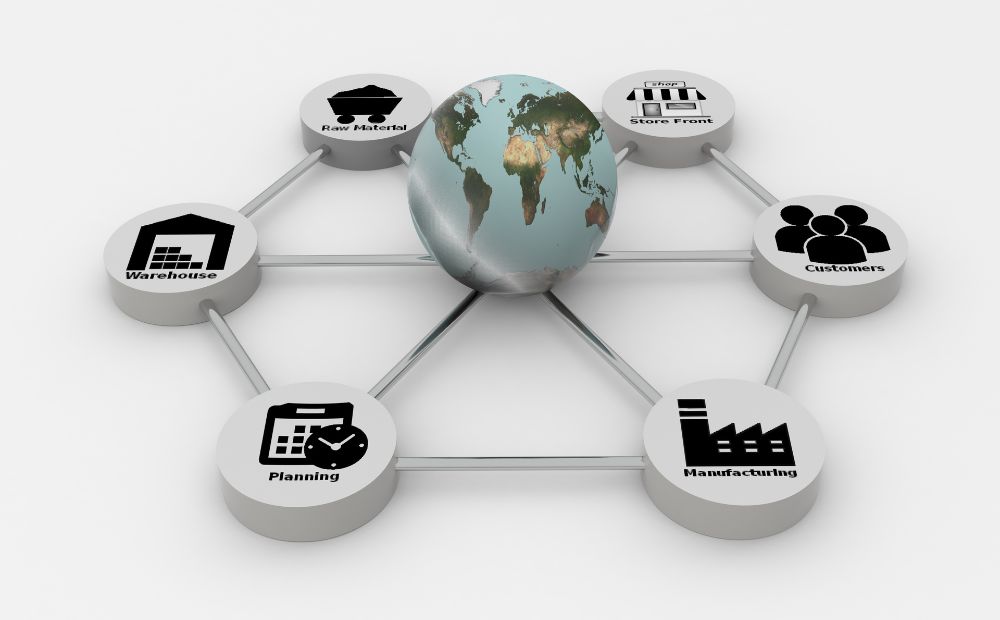Unlock Supply Chain Resilience: 7 Proven Strategies for Success

Within today’s interconnected and globalized society, businesses are increasingly prioritizing the resilience of their supply chains. Various disruptions, whether caused by natural disasters, geopolitical events, or pandemics, can significantly impact supply chains, leading to delays, increased costs, and revenue reduction. This blog delves into the essential concept of supply chain resilience, highlighting its importance, key components, methods for enhancement, and real-world examples. Supply chain resilience is characterized by the ability of a supply chain to anticipate, plan for, respond to, and recover from disruptions, integrating factors like flexibility, adaptability, and robustness.
Table of Contents

During the turn of the millennium, efforts were made in supply chain risk management to shift traditional risk management methodologies from a singular company system to an interconnected supply chain system. Nonetheless, conventional risk management processes like risk identification, assessment, treatment, and monitoring encounter challenges in scalability. While it is feasible to identify all potential risks within a single company, supply chains frequently encompass numerous companies, making the comprehensive identification of risks significantly more intricate and potentially futile.
The concept of enhancing supply chain resilience has gained popularity in contemporary supply chain management discussions. Advocates argue that the intricate nature of supply chains necessitates additional measures such as supply chain resilience, which focuses more on the system’s characteristics and its ability to adapt to various disruptions rather than merely identifying specific risks. Ensuring a strong supply chain is essential in the complex and unpredictable modern business environment. To achieve this, companies must focus on investing in five key pillars of resilience: Visibility – The ability to track and monitor the supply chain in real-time,
Flexibility – The capacity to adjust operations and processes quickly.
Collaboration – Strong relationships and communication across the supply chain.
Redundancy – Having backup resources and pathways to mitigate risk.
Risk Management – Identifying and mitigating potential risks proactively.
Importance Of Supply Chain Resilience
Ensuring supply chain resilience is crucial for both businesses and economies as it ensures operational stability and continuity in the face of disruptions. The subsequent points elucidate the primary reasons for its importance.
Minimizing Disruption Impact
In order to reduce the impact of disruptions, supply chain disturbances may stem from diverse sources, including but not limited to natural calamities, geopolitical conflicts, cyber warfare, and health crises. An adaptable supply chain can promptly respond to these disruptions, thereby lessening their effects on business operations. For instance, amid the COVID-19 pandemic, numerous organizations with resilient supply chains successfully sustained their operations by reallocating production to alternate locations and engaging different suppliers.
Enhancing Customer Satisfaction
Ensuring customer satisfaction requires timely delivery of products, which is essential for preserving trust and loyalty. A robust supply chain plays a vital role in guaranteeing on-time product delivery, even in the face of disruptions, thus safeguarding the company’s image and customer retention. For instance, e-commerce firms have made significant investments in their supply chain infrastructure to offer swift delivery times, a pivotal element in maintaining elevated levels of customer satisfaction.
Enhancing Competitive Advantage
Companies that possess resilient supply chains can react promptly to market fluctuations and disruptions, providing them with a competitive advantage over rivals who are less prepared. This flexibility enables them to take advantage of emerging prospects and manage risks more efficiently.
Ensuring Continuous Operations Providing Efficiency
In industries employing just-in-time (JIT) production methods, ensuring operational continuity is of utmost importance. A robust supply chain helps prevent disruptions in the supply of materials and goods, which is crucial for maintaining ongoing production and operational activities. To illustrate, Toyota’s JIT manufacturing strategy heavily relies on a dependable supply chain that delivers components precisely on time to prevent any downtime. Likewise, Dell’s direct-to-consumer approach hinges on an efficient supply chain to promptly put together and deliver personalized computers, thereby guaranteeing customer contentment and operational effectiveness.
Reducing Financial Losses
Disruptions in the supply chain have the potential to cause substantial financial losses through production stoppages, cost escalation, and decreased sales. The implementation of a resilient supply chain strategy is effective in mitigating these financial risks by enabling operations to either persist or swiftly recover following a disruption. For example, a manufacturing firm with a resilient supply chain will have diversification among suppliers for essential components. In the event of a natural disaster impacting one supplier, the company can promptly transition to an alternate supplier, thereby reducing downtime and preventing production interruptions. This rapid response contributes to sustaining revenue streams and minimizing the risk of financial losses.
Long-Term Sustainability
Resilient supply chains play a key role in fostering the long-term sustainability of businesses by enhancing their ability to endure and rebound from disruptions. This sustainability is pivotal in instilling investor trust and ensuring the longevity of the company. For instance, companies that uphold robust environmental, social, and governance (ESG) practices frequently possess more resilient supply chains due to their proactive approach in managing risks concerning climate change, human rights, and ethical sourcing.
Facilitating Regulatory Compliance
Increasingly intricate regulatory environments require a heightened focus on supply chain transparency and risk management. A robust supply chain assists businesses in adhering to regulations and circumventing penalties. For instance, the European Union mandates strict regulations regarding supply chain transparency and sustainability, necessitating companies to maintain resilient and well-documented supply chains to ensure compliance.
Strategies to Enhance Supply Chain Resilience
Diversification of Suppliers
Diversification of suppliers in the supply chain means sourcing goods or services from multiple suppliers instead of relying on a single source. This strategy reduces dependency, enhances resilience against disruptions, provides cost savings, and fosters access to innovation. Let’s look into some examples:
- Apple: The tech giant diversifies its supplier base for critical components like semiconductors, sourcing from suppliers across countries such as Taiwan, South Korea, and China.
- Nike: Nike strategically diversifies its manufacturing partners, with production facilities located in various countries like China, Vietnam, and Indonesia, reducing vulnerability to disruptions in any single region.
- Unilever: Unilever collaborates with numerous suppliers globally to source raw materials for its consumer goods, ensuring a steady supply chain even amidst regional challenges or geopolitical tensions.
- Nokia: Nokia diversifies its supplier base for electronic components used in its smartphones, collaborating with suppliers from different regions to mitigate supply chain risks.
- IKEA: IKEA sources furniture materials from various suppliers across Asia, Europe, and North America, ensuring a diverse and resilient supply chain for its global operations.
- Ford Motor Company: Ford partners with multiple suppliers for critical automotive components, such as engines and transmissions, reducing dependency on any single supplier and enhancing supply chain resilience.
Investment in Technology
Investment in technology for supply chain resilience involves using digital tools like IoT, AI, and blockchain to improve visibility, predict disruptions, automate processes, enhance collaboration, and ensure traceability across the supply chain. Let us look into the examples to understand better:
- FedEx: FedEx invests in cutting-edge logistics technologies, including AI-powered route optimization algorithms and real-time tracking systems, to enhance supply chain visibility and responsiveness.
- Intel: Intel leverages advanced data analytics and machine learning tools to optimize its manufacturing processes, enabling the semiconductor giant to forecast demand accurately and adapt production accordingly.
- UPS: UPS deploys IoT sensors and telematics devices in its delivery vehicles to monitor shipment conditions in real-time, ensuring the integrity and security of packages throughout the supply chain.
- Amazon: Amazon leverages AI and machine learning algorithms to analyze customer data and forecast demand accurately, enabling the e-commerce giant to optimize inventory levels and ensure timely delivery.
- Coca-Cola: Coca-Cola utilizes blockchain technology to enhance transparency and traceability across its supply chain, enabling better management of inventory and ensuring product authenticity.
Building Redundancies
Building redundancy in supply chain resilience involves creating backup systems, processes, or resources to minimize the impact of disruptions. This includes maintaining surplus inventory, diversifying suppliers, establishing backup facilities, using alternative transportation modes, and cross-training employees. Let us now look into some examples:
- Boeing: Boeing maintains backup production facilities for aircraft components, allowing the aerospace manufacturer to mitigate the impact of disruptions and ensure continuous aircraft assembly.
- Nestlé: Nestlé strategically warehouses raw materials and finished goods in multiple locations worldwide, reducing the risk of supply chain disruptions and ensuring product availability for consumers.
- General Electric (GE): GE establishes redundant supply sources for critical components used in its industrial equipment, enabling the conglomerate to maintain operations during supplier disruptions or shortages.
Strengthening Supplier Relationships
Strengthening supplier relationships in supply chain resilience involves fostering collaboration, trust, and communication with key suppliers. This includes sharing information, jointly addressing challenges, and developing long-term partnerships to enhance resilience and adaptability. Some examples:
- General Motors (GM): GM works closely with its suppliers to share production forecasts and develop contingency plans, enabling timely adjustments to production schedules and inventory levels.
- IKEA: IKEA collaborates with its suppliers to implement sustainable practices and improve supply chain transparency, fostering trust and resilience throughout the supply chain network.
- Samsung: Samsung maintains long-term relationships with its suppliers, providing them with technical assistance and support to enhance manufacturing processes and product quality, ensuring a reliable supply of components for its electronic devices.
Scenario Planning and Simulation
Scenario planning and simulation in supply chain resilience involve preparing for potential disruptions by creating hypothetical scenarios, simulating their impact, and developing contingency plans. This proactive approach helps identify vulnerabilities, improve decision-making, and enhance resilience in the face of uncertainty. A few examples are as follows:
- FedEx: FedEx utilizes advanced modeling and simulation tools to assess the potential impact of disruptions such as severe weather events or network congestion, enabling the logistics company to proactively adjust routes and allocate resources.
- Nestlé: Nestlé conducts regular risk assessments and scenario planning exercises to evaluate supply chain vulnerabilities and develop resilience strategies, ensuring the continuous supply of food and beverages to customers worldwide.
- IBM: IBM employs predictive analytics and scenario modeling to anticipate supply chain disruptions and optimize inventory management, enabling the technology company to maintain operational efficiency and meet customer demands even in challenging environments.
Geographical Diversification of Manufacturing
Geographical diversification of manufacturing in supply chain resilience involves spreading production facilities across different regions to reduce the risk of disruptions. This strategy ensures operational continuity and flexibility to adapt to diverse challenges in various geographic areas.
- Microsoft: Microsoft operates manufacturing facilities in various countries, including the United States, China, and Ireland, diversifying its production footprint and reducing exposure to geopolitical risks or localized disruptions.
- Honda: Honda has manufacturing plants located in different regions such as Japan, North America, and Europe, enabling the automaker to adapt production and distribution strategies based on market conditions and regulatory requirements in each region.
- Nestlé: Nestlé maintains a global network of production facilities for its food and beverage products, ensuring redundancy and flexibility in manufacturing operations to address local market demands and mitigate supply chain risks.
Enhancing Supply Chain Visibility
Enhancing supply chain visibility in supply chain resilience involves improving real-time tracking, end-to-end transparency, predictive analytics, collaborative platforms, and supply chain mapping to make informed decisions, proactively manage risks, and improve responsiveness to disruptions. Some examples for better understanding:
- Walmart: Walmart utilizes RFID technology and data analytics to track inventory movement in real-time across its global supply chain network, enhancing visibility and enabling proactive inventory management and replenishment.
- Maersk: Maersk, the world’s largest container shipping company, offers customers real-time tracking and visibility solutions through its online platform, allowing shippers to monitor the status and location of their cargo throughout the transportation process.
- Cisco: Cisco employs blockchain technology to enhance transparency and traceability in its supply chain, enabling better collaboration with suppliers and partners and ensuring the authenticity and integrity of products and components.
Fostering Flexibility and Agility
Fostering flexibility and agility in supply chain resilience involves developing the ability to quickly adapt to changes and disruptions. This includes dynamic capacity management, responsive operations, collaborative partnerships, data-driven decision-making, and embracing lean principles.
- H&M: H&M operates a fast-fashion supply chain model that allows the company to quickly respond to changing consumer trends and market demands by adjusting production schedules and inventory levels in real-time.
- McDonald’s: McDonald’s employs a modular supply chain system that enables the fast-food giant to introduce new menu items and promotions quickly while optimizing supply chain efficiency and reducing waste.
- Flex: Flex, a global manufacturing and supply chain solutions company, offers customers agile and responsive supply chain services, allowing them to adapt production and distribution strategies based on changing market conditions and customer preferences.
Ultimately, supply chain resilience plays a critical role in assisting organizations in effectively managing disruptions and maintaining operational functions. It is imperative for companies to reassess their procedures and operational workflows in order to remain pertinent in an ever-evolving setting. Through expedited alterations to their supply chains and harnessing cutting-edge technologies, enterprises can dismantle organizational barriers, attain comprehensive visibility, and improve real-time information exchange and cooperation. By collaborating on innovative solutions, the sector can effectively navigate obstacles, adapt to changing demands, and uphold its essential function in global trade and commerce.
TransportNext Awards, Conference, and Expo
Logistic Events are vital for gaining insights into industry practices and innovations, facilitating meaningful connections, and opening doors for shared resources. An annual premier worldwide event, the TransportNext Awards, Conference, and Expo is organized by Next Business Media in Singapore and the United States. The transport and logistics community throughout the rest of the world is served by the Singapore edition. By taking advantage of Singapore’s advantageous position, it offers a forum for global cooperation and knowledge sharing.
TransportNext Singapore provides enlightening talks, engaging workshops, and a large expo. It also highlights innovative solutions and promotes strategic alliances. The TransportNext Awards, which honor achievements in the sector, are the focal point. This Logistics event guarantees an unmatched networking and growth-promoting experience because of its global reach and dedication to Logistics and Transportation industry improvement.





